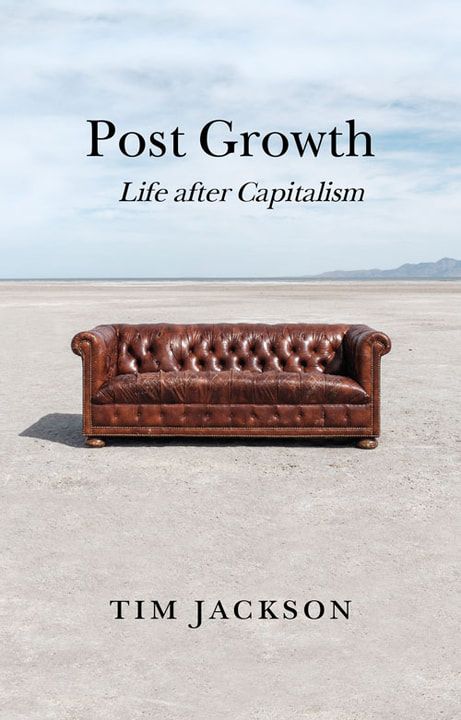
Post Growth: Life After Capitalism
Life After Capitalism answers the question: what should be society’s focus if we shake off our obsession with GDP growth? It draws on Jackson’s recent role as director of the inter-disciplinary Centre for the Understanding Sustainable Prosperity and plucks ideas from many disciplines

Published by Polity, 2021
Life After Capitalism is Jackson’s first major book since his influential, multiple award-winning Prosperity Without Growth (PWG) published in 2009. It is more prequel than a sequel to PWG and does not address the frequent criticism levelled against the earlier book: without growth, how do we ensure full employment or adequate incomes? These are topics Jackson is hopefully tackling in his ongoing collaboration with Peter Victor.
Instead, Life After Capitalism addresses the prior question: what should society aim for if people jump off the treadmill of production? It illustrates this by dipping into the lives and ideas of an idiosyncratic collection of people that guided Jackson in his quest for a good life. The book continues in the tradition of a couple of classic environmental texts; its antecedents include Schumacher’s Small is Beautiful and Galbraith’s Affluent Society, both of which Jackson mentions.
Jackson sketches pen portraits of a range of influences providing enough biographic detail to humanise them. This eclectic mix includes the melancholic, child prodigy John Stuart Mill, the poet and hermit Emily Dickenson, the microbiologist and overly multi-tasked Lynn Margulis and the physicist Boltzmann, who somehow connected love to entropy in a lost lecture.
At its core, this book makes the argument “growth matters when there is material insufficiency…and [society needs to understand] how to stop when we get there”.
This need to stop puts Jackson at odds with capitalism. The debate sparked by Prosperity Without Growth, which I witnessed first-hand as an environmental economist within government, was whether green growth, the reduction in the intensity of environmental usage per unit of GDP, could exceed the rate of economic growth. If the answer was yes, there was hope for the planet; if not, green growth was a false God. His earlier book offered ample statistical evidence that the sought-after decoupling was not occurring sufficiently. Prosperity Without Growth attracted anger from techno-optimists affronted by its pessimism and its rejection of ‘the creed of the green growth’ who believe ‘our ingenuity is not just legendary, it’s evolutionary’ (p43).
Life After Capitalism is unlikely to provoke such emotions. In many ways, it rehashes familiar ground. The book discusses (Chapter 1) Robert Kennedy’s lyrical critique of GDP and society’s obsession with material accumulation. The timing of the senator’s 1968 speech was almost concurrent with the Club of Rome’s meeting to discuss the Limits to Growth and Herman Daly’s publication of a landmark paper discussing ecological and physical constraints on economic growth.
The medieval stone bridge at Potter Heigham, Norfolk, appears as a useful prop in Chapter 3. It is a decidedly non-metaphorical limit-to-growth since its diminutive size forces sailors wishing to thread through the stone arch to apply skill and utilise favourable tides. Consequently, the river upstream of the bridge has become a haven for non-powered boats and wildlife, while downstream is the standard menu of motorised boats and tacky riverside developments.
One theme is that the devil has the best tunes. Capitalism has won the narrative in the sense that the lexicon of Davos technocrats (Chapter 6) now dominates our understanding of good policy and draws inspiration from the Darwinian inevitability of competition and our ‘relentless struggle for existence’. This agenda equates growth with progress and naturally applies quantitative easing to rescuing countries and companies from the financial crisis, whilst allowing the slow, slithering desecration of our environment and social capital to persist. Jackson tries to stem this intellectual tide. There is a segue-way into the miraculous discoveries of Lynn Margulis, who identified co-operation, indeed symbiosis, as the principal interaction between organism. All plant and animal cells for the last billion years contain mitochondria in which bacteria slave tirelessly providing energy from sugars in exchange for safe shelter.
Capitalism’s disfigurement of work is covered in Chapter 7. He rightly castigates today’s denigration of physical labour, caring professions, bad-faith zero-hours contracts and the de-skilled assembly line propelled by capitalism’s constant chiselling away of the dignity of work in the name of greater efficiency. But aside from appealing to a William Morris style call for arts and crafts, it’s unclear what people can do to stop the ongoing theft of good jobs by robots or the new wave of Deep Mind AI.
One real-life expression of steady-state thinking is in agriculture and humanity’s millennia-long stewardship of soils. Fittingly, Kenyan agro-biologist and politician Maathai Wangari is the book’s champion of organic and climate-friendly farming with its natural nutrient cycles. The chapter also shows the difficulty reconciling the financial sector’s search for big-ticket, high-yielding investment opportunities with the small-scale, slow growth rate realities of small inter-cropped farms.
Capitalism’s most significant scalp is hope. Through its denigration of care, its stimulation of material desires, its rough-shod treatment of the environment, it creates a “relentless and inevitable insecurity”. In common with many books published this year, the pandemic lurks in the book’s shadows. How do people cope with the lockdown? Not covered by the book, an interesting question is how easily wealthy people accustomed to distant holidays, fragrant spas, boutique hotels, and classy restaurants adjusted to their absence. The curtailment of conspicuous consumption might be quite tolerable when everyone else is in the same boat.
Jackson writes beautifully, and there are interesting insights about people we may have heard of but don’t know much about. But the book’s big ideas will be familiar to much of the readership.
My biggest issue with the book is the nature of the evidence deployed. Unlike his previous two books steeped in science and engineering (Material Concerns) and statistics (Prosperity Without Growth), the book relies on rhetoric and biographic case study to argue the nature of a good life and inspire the reader to change. The problem with case studies is whether the insights are universally applicable. Few others would wish to live Emily Dickinson’s life of self-imposed lockdown to create immortal poetry. Jackson’s ‘ghost in the mirror’ is one sort of existence, but it might not have a broad appeal. The book’s villain is capitalism, but maybe capitalism is miscast, and the true villain is democracy and ourselves. How many of us collectively or individually asked to choose between self-denial and self-gratification would choose the former? Sadly, precious few and we expect our governments to behave likewise.
On a personal note, during the lockdown, I became an avid fan of the TV quiz show Pointless (a competition for money) and a would-be novelist (a hobby unlikely to yield me monetary benefit). Maybe a love of money and creativity are not really in opposition but are two inevitable facets of the human condition.



